
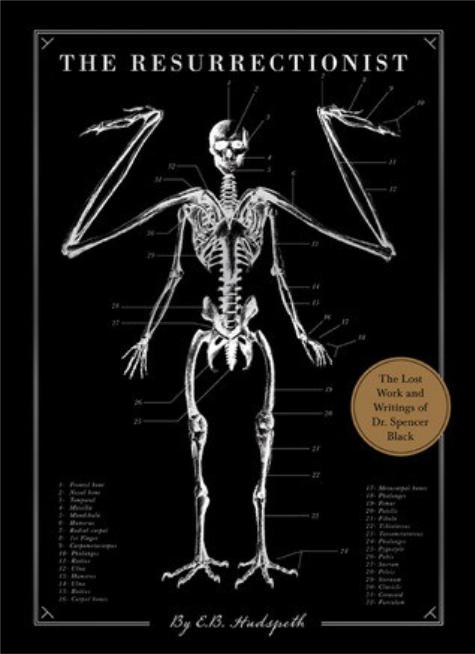
AN EXTRAORDINARY
BIOGRAPHY.
A GALLERY OF
ASTONISHING ARTWORK.
THE LEGACY OF A
MADMAN.
Philadelphia, the late 1870s. A city of gas lamps, cobblestone streets, and horse-drawn carriages—and home to the controversial surgeon Dr. Spencer Black. The son of a grave robber, young Dr. Black studies at Philadelphia’s esteemed Academy of Medicine, where he develops an unconventional hypothesis: What if the world’s most celebrated mythological beasts—mermaids, minotaurs, and satyrs—were in fact the evolutionary ancestors of humankind?
The Resurrectionist offers two extraordinary books in one. The first is a fictional biography of Dr. Spencer Black, from a childhood spent exhuming corpses through his medical training, his travels with carnivals, and the mysterious disappearance at the end of his life. The second book is Black’s magnum opus: The Codex Extinct Ammalia, a Gray’s Anatomy for mythological beasts— dragons, centaurs, Pegasus, Cerberus—all rendered in meticulously detailed anatomical illustrations. You need only look at these images to realize they are the work of a madman. The Resurrectionist tells his story.
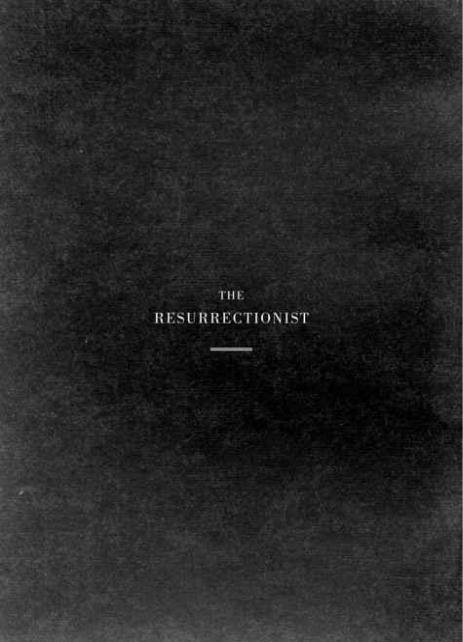
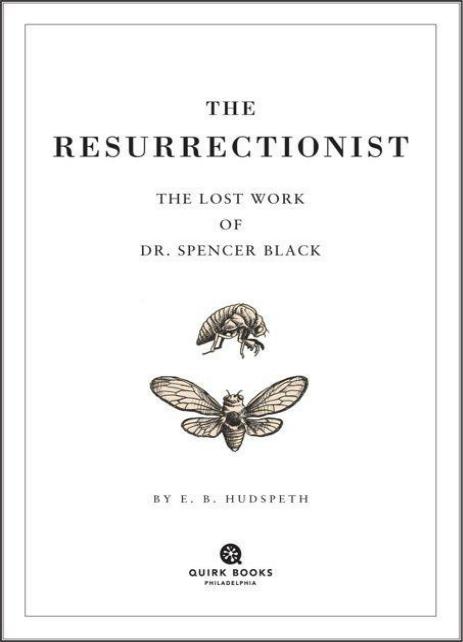

Copyright © 2013 by Eric Hudspeth
All rights reserved. No part of this book may be reproduced in any form without written permission from the publisher.
Library of Congress Cataloging in Publication Number: 2012934523
Hardcover ISBN: 978-1-24601-616-1
eBook ISBN: 978-1-24601-624-6
Designed by Doogie Horner Production management by John J. McGurk
Quirk Books
215 Church Street
Philadelphia, PA 19106
10 9 8 7 6 5 4 3 2 1

Cover
Other Books by This Author
Title Page
Copyright
Epigraph
A NOTE FROM THE PUBLISHER
THE LIFE AND WRITINGS OF DR. SPENCER BLACK
1851–1868: CHILDHOOD
1869: THE ACADEMY OF MEDICINE 1870: WARD C
1871–1877: MARRIAGE AND
TRANSFORMATION 1878: THE FAWN-CHILD
1879–1887: THE AMERICAN CARNIVAL 1888–1908: THE HUMAN RENAISSANCE
THE CODEX EXTINCT ANIMALIA
SPHINX ALATUS
SIREN OCEANUS
SATYRUS HIRCINUS
MINOTAURUS ASTERION
GANESHA ORIENTIS
CHIMÆRA INCENDIARIUS
CANIS HADES
PEGASUS GORGONIS
DRACONIS ORIENTIS
CENTAURUS CABALLUS
HARPY ERINYES
A Final Note

A NOTE FROM THE PUBLISHER
THIS BOOK WOULD NOT exist without the tireless efforts and generous financial support of Philadelphia’s Museum of Medical Antiquities.
Over the past fifteen years, their curators have toured private collections throughout the United States and Europe in search of the lost journals, letters, and illustrations of Dr. Spencer Black, one of the most remarkable physicians and scientific mavericks Western civilization has ever known.
As most physicians and students of medicine undoubtedly already know, Dr. Black achieved fame and notoriety in the late nineteenth century for his pioneering work in treating genetic abnormalities. No one disputes that Dr. Black was a genuine prodigy; before he had even reached the age of twenty-one, his work was known by surgeons around the world. And yet this professional acclaim was short-lived. Much of Dr. Black’s later work remains shrouded in controversy, rumors, and whispers of blasphemous abominations. Thanks to the materials collected herein, we now know that Dr. Black’s personal and professional exploits were far more scandalous than anything found in the gothic novels that were popular during his lifetime.
Many of the letters and illustrations in this book were
donated from the estate of Dr. Black’s brother, Bernard. These materials have been unseen since the International Convention of Modern Science in 1938 (where their display was fleeting, because of public disapproval). Other letters, journals, and drawings have come to us directly from anonymous donors, and these are published here for the first time. They offer startling new insights into the doctor’s personal life and professional achievements.
This publication begins with the most complete biography to date of the Western world’s most controversial surgeon. It is followed by a near-complete reproduction of Dr. Black’s magnum opus, The Codex Extinct Animalia.
Together, these two extraordinary documents are the definitive study of Dr. Spencer Black. They are The Resurrectionist.
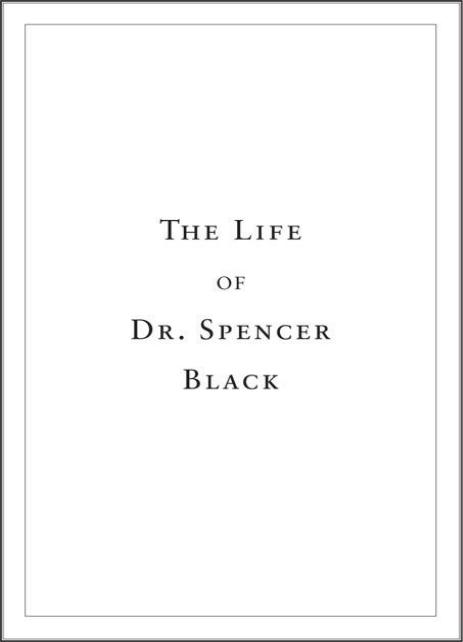
1851–1868
CHILDHOOD
In my childish imagination, God’s wrathful arm was
ever-ready and ever-present. —Spencer Black
Dr. Spencer Black and his older brother, Bernard, were born in Boston, Massachusetts, in 1851 and 1848, respectively. They were the sons of the renowned surgeon Gregory Black. Their mother, Meredith Black, died while delivering Spencer; her passing caused a great unrest in both boys throughout their childhood.
Gregory Black was a respected professor of anatomy at the Medical Arts College of Boston. He conducted dissections for students at a time when cadavers were scarce and anatomists depended on grave-robbing resurrectionists to further their research. He had some of his favorite cadavers preserved, dressed, and propped up in a macabre anthropomorphic display in his office. As
one of the city’s leading professors, with an increasing number of students every year, his demand for bodies surpassed the legal supply. He was one of the primary purchasers of stolen cadavers in the area, and he dug up many additional bodies himself, with the assistance of his two young sons. Spencer Black writes at length about these experiences in his journals.
I was no older than eleven when the ordeal began. The night I remember above all, I was hurried out of bed after my brother, Bernard: my elder by three years. He was always stirred awake first so he could help prepare the horse and tie up the cart.
Hours before dawn, in the cool of the night, we walked away from our home and went down to the river where we could cross a bridge; beyond which the road was dark and obscured, an excellent place to enter and leave the cemetery unnoticed.
We were all quiet, for calling attention to ourselves would have done us no service. It was damp and wet that night: it had rained earlier and I could smell water still fresh in the air. We slowly moved along the bridge. I remember the wheels of the cart, straining and creaking, threatening to arouse the nearby residents and their curiosities with just one sudden noise. Steam rose off our aged horse. The mist of her breath was comforting; she
was an innocent creature—our accomplice. The narrow stream below, too dark to see, trickled quietly. Any sound that we made with our dreary march was muted as soon as we crossed the bridge and went over the moss-covered earth framing the cemetery. Once inside the perimeter my father was at ease, his humor improved, and with a calm gaiety he led us to a newly established residence for some deceased soul. They called us resurrectionists, grave robbers.
When I was a child I hadn’t the conviction against the belief in God that I have now. My father was not a religious man, however my grandparents were, and they gave me a rigorous theological education. I was very much afraid of what we did those nights; of all the terrible sins a man might commit, stealing the dead seemed among the worst. In my childish imagination, God’s wrathful arm was ever-ready and ever-present. And yet I feared my father even more than I feared my God.
My father reminded us there was no cause for trepidation or fear. He would repeat these things as we dug through the night, as the smell of the body’s decay rose around us. Soon we reached the soft, damp, wood coffin of Jasper Earl Werthy. The wood cracked, releasing more of death’s repugnant odor. I put my spade down, grateful that my father was
wrenching the wood and freeing the body himself, sparing us this task. Jasper’s face was a sunken gray mask; his skin was like a rotten orange. This is how I came to understand my father’s profession.
Soon afterward, Dr. Black penned another journal entry with a short poem titled “A Dreadful Sight.” The poem appears to be inspired by his experiences robbing graves. It is the only known work of poetry found among Dr. Black’s papers and reflects a creative impulse that manifested itself in his numerous illustrations.
A Dreadful Sight
I went to rest one merry night, On the morrow was a dreadful sight. My dear loved one has passed away.
So to the coffin she must stay.
In the earth where ’tis quiet and calm to rest in peace till the Lord has come.
I go to visit, weep and mourn. Lo’ my loved one’s body has gone. Not to heaven where she belongs
but from the grave to the doctor’s room.
In the winter of 1868, Spencer Black’s father, Gregory, died from smallpox, a disease that some say he would
have been brilliant enough to cure had he been given forewarning. Soon after the funeral, Spencer announced his decision to become a medical doctor. It’s clear throughout Black’s writings that he thought of death as an abstract concept; he often calls death “the phenomenon of the living” and even regarded the passing of his own father as more of a curiosity than a tragedy.
As he lay in the ground, and the dirt and the sod were laid over him, all was quiet. I waited for a long space of time. I waited to hear something: a command or suggestion, a provocation that might confirm that his death took something away from me, but I received no such thing.
Bernard Black kept a separate journal of his life and work in the natural sciences until his disappearance in 1908. His wife, Emma, published some of his writings in her book entitled A Journey with an American Naturalist. This entry was written in the same week as the patriarch’s death:
At that moment, when I had a great and heavy pain that was suffered upon me by our father’s death, I could see Spencer at that very identical moment looked exalted. He leapt into my father’s grave with all his heart, chasing after death to seek out its hiding place.
After the passing of their father, Spencer and Bernard moved to Philadelphia in the fall of 1869 and were placed in the care of their uncle Zacariah and aunt Isadore. The funerary costs were quite extensive; Gregory had set some money aside for his burial, but it was not enough. Zacariah and Isadore paid the balance out of their savings, and it was likely a significant sum. Then, as now, a proper burial came at a high price.
1869
THE ACADEMY OF
MEDICINE
The truth is a commodity that is rarely distributed in these empirical times. What evidence can be given
that the sun is bright on both of its sides? I cannot prove this, so is it thusly untrue?
—Sir Vincent Holmes, biologist, founder of the Academy of Medicine
Prior to moving to Philadelphia, Bernard had already completed three years of schooling at the Medical Arts College of Boston, whereas Spencer had completed just one. Both young men enrolled in Philadelphia’s Academy of Medicine to continue their studies. It was during this year that Spencer began keeping his journal.
September 1869
What a miracle it is to be human! I endeavor to write this account of my life, the chronicling of my study and experience with the Academy of Medicine here in Philadelphia—not my place of birth. It was not by my choosing that I would pursue a career in medicine—this is a matter of fate, God, destiny, or some other weapon of man.
I was born of good and well-educated parents, both of whom are now gone. My mother died delivering birth to me while my father attended. He held my life in one hand and her death in the other. He did not often speak of her.
It was in the winter of my sixteenth year when my father succumbed to smallpox: a disease that took his life. I am certain that I mourned my father’s death; however, I did not weep.
As he lay in his coffin, I thought he may likely rise again. He may come out of the hole, bundled in rags by unknown men with faces obscured by darkness and soot or ash. He would then be dragged down the path and loaded into a cart. A few seconds would pass, then the reigns would snap and the horse would carry him away. My father was a well-known and respected doctor and anatomist. He certainly paid for many corpses for his research; now he too may serve science yet again.
When one dies they neither ascend to the heavens
nor descend to hell, they instead become cured— freed from an illness and healed from the suffering of mortality. Our consciousness, our awareness, is a symptom of our body and it is secondary to the mystery of our physical chemistry. It is in this sincere application to biology where I promise to excel as a scientist of medicine. The entire body is the soul, and my knife cuts deep into the flesh; I vow to be always reverent with the edge of my scalpel.
Spencer Black excelled at the Academy of Medicine. It was evident to both his peers and his teachers that he would soon be a fledgling practitioner in the medical arts. Noted for being extremely serious and clever for his age, Spencer made a name for himself as one of the most promising prodigies in the country. Bernard’s interests were quite different: he had decided to focus his work on the natural sciences, fossils, and history.
One of Spencer’s most influential professors was Joseph Warren Denkel, a Scottish immigrant who first studied at the Medical Arts College of Boston, where he met Spencer’s father as a fellow student. He later worked as a field surgeon during the Civil War, performing hundreds of amputations; many of these resulted in death by infection. At Philadelphia’s Academy of Medicine, Denkel was perceived as a charismatic physician, often jocular with staff and patients, prone to gambling and
other raucous behavior in the evenings. He and Spencer Black became good friends.
During this time in American medicine great and dramatic changes were occurring rapidly throughout not only this country but the world as well. Physicians were beginning to understand bacteria and its role in infection. Sanitation practices were improving. The practice of washing hands or dipping them in carbolic acid was increasingly common, replacing older notions that dried blood on surgeons’ hands acted as a sanitary barrier or that sanitation had no correlation to infection during surgery. The introduction of anesthesia revolutionized surgery; it allowed the surgeon more time to perform the work without worrying about the patient’s pain. Black welcomed these advancements and was excited about contributing ideas of his own.
During his first year at the academy, in 1869, Black began to research mutations of the body—specifically, physical abnormalities that manifest in dramatic, unique, and even fatal ways. However, studying people maligned with these conditions was not easy. They often died early or were difficult to find because they were secluded from the public. Much of Black’s early work was influenced by his experiences at the Grossemier Museum in downtown Philadelphia. In the museum’s collection was a famously peculiar skeleton of parapagus dicephalus dibrachius (conjoined twins); the skeleton was named Ella and
Emily; the girls had died at birth. He wrote his first paper about their unfortunate condition. The result was highly praised but not well distributed; much of Black’s work was considered less worthy of discussion than the research of infectious diseases, more efficient surgical practice, or improved anesthesia. Many thought the young doctor was wasting his time on birth defects. Black wrote about some of his frustrations during that time:
I am engrossed in anatomical research now. Denkel is assisting my efforts despite what other professors have called, “unnecessary and fruitless interests in mutations of the body.” He is either ignorant of their counsel or genuinely interested in my research—I tend to think it’s the latter.
The miracle of life is granted, and how that miracle can be defective is a nuance that I am most interested in understanding. Denkel and I are preparing another article for publication this spring. I trust it should prove quite insightful.
Spencer Black began taking illustration seriously during his first year at the academy. It was not uncommon for doctors to sketch their notes and findings, but Black was excessively good at the practice, and he found work in the evenings drawing the work of other researchers. One of these was the renowned botanist and traveler Jean DeLain.
DeLain’s collection was kept at the Broadshire
University Atrium, where Black would often go to study. He would continue to work for DeLain off and on for many years, illustrating hundreds of specimens for him.
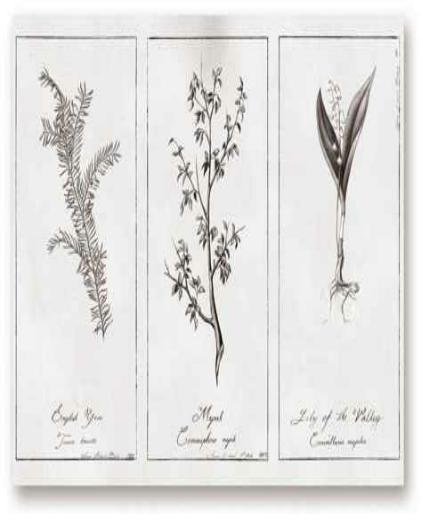
Three of the plants that Spencer Black illustrated for the botanist Jean DeLain; all are well known for their distinct properties.
The English Yew bears a seed that is extremely poisonous. The tree can live for more than two thousand years; some are believed to be as old as nine thousand years. In certain spiritual circles, the yew is celebrated for its transcendence of death. Its resilience has inspired many cultures to revere it as a symbol of rebirth and everlasting life.
Myrrh is the tree from which the reddish-brown gum resin is derived; it is famous among Christians for being one of the three gifts bestowed on the infant Jesus. Myrrh is a well-known incense and is still used for its aromatic and medicinal qualities.
Lily of the Valley, extremely poisonous, has many stories and legends ascribed to it. Also known as Our Lady’s Tears, the plant is believed to have sprung from the tears of Mary while she wept at the crucifixion of her son Jesus Christ. It is believed that the plant can grant the power to envision a better world. It also symbolizes the return of happiness, or the return of Jesus Christ.
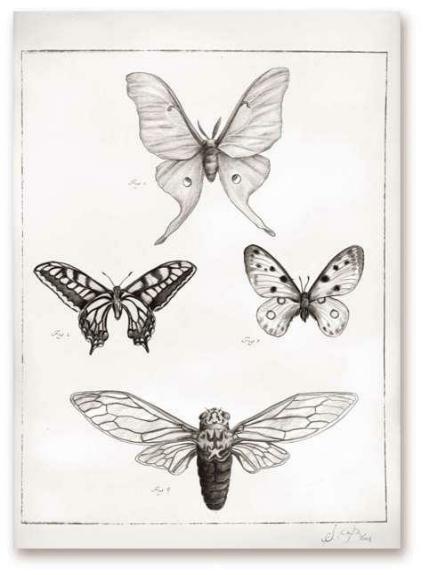
Figure 1. Actias luna-male Luna Moth
Figure 2. Papilio machaon Swallowtail Butterfly
Figure 3. Parnassius apollo Apollo (Mountain Apollo) Butterfly
Figure 4. Pomponia imperatoria Empress Cicada
I am making notable improvements in my illustrations. What a reprieve from words and lectures. I can study, think, and relax more while taking care to lavish in the solitude of drawing.
Spencer Black also wrote about many of the insects and plants that he studied. He was particularly interested in insects that underwent a metamorphosis. The process of transformation fascinated the young scientist, and he often sketched the cicada and made regular mention of it in his journals and letters.
November 22, 1869
In the summer, when the cicadas emerge from the ground, they transform into a winged insect, sing their song, mate, lay eggs, and soon die. The pupae hatch from their eggs in a tree then fall to the ground and burrow deep into the earth, where they live for more than a decade.
Such evanescence; to emerge from the ground after such a long time and then transform, gaining wings. They are born once again from the womb of their own body, which is abandoned as an empty shell, and then they leave the world. This type of metamorphosis (though not as dramatic as that of the butterfly or moth, in a superficial context) is, in my esteem, one of the more significant. After such a long time in darkness, we can live for only a short
while.
* * *
December 1, 1869
I have become interested in a different assignment given to me by Professor Jean DeLain. He needs several illustrations of small and curious insects illustrated for a book he is compiling; the insects gathered are all dead, carefully packed and pinned. They have arrived from many locations of the world: Guinea, the Malaysian islands, Africa and Asia. It is exciting to study the smallest differences in their particular designs. There is little separation between man and insect, save the marvels solely unique to their respective functions in nature.
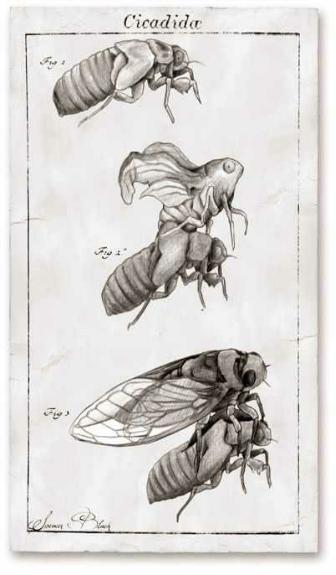
Figure 1. The pupa stage, freshly emerged from the ground.
Figure 2. The insect emerges from its shell, reborn. It waits to gain its strength.
Figure 3. Now fully developed, the cicada can fly away, sing its song, mate, and the cycle can repeat.
